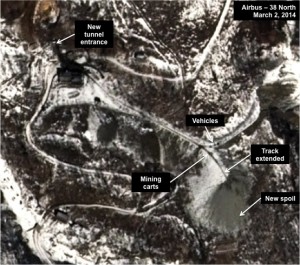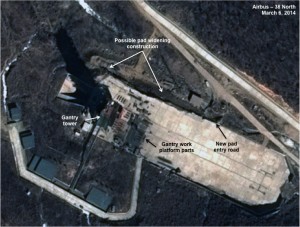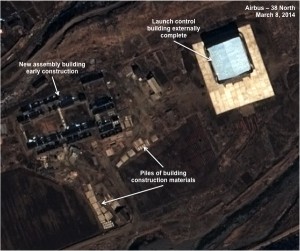North Korea’s Nuclear and Rocket Test Sites: Activity Continues but No Sign of Test Preparations.
Summary
Recent commercial satellite imagery of North Korea’s nuclear and rocket test sites indicates that while activities continue, there is no evidence to suggest preparations for impending nuclear or long-range rocket tests.
- Excavation continues on a new tunnel in the West Portal area of the Punggye-ri Nuclear Test Site, but there is little or no activity at other key parts of the facility.
- Construction continues at the gantry and launch pad at the Sohae Satellite Launching Station (Tongchang-ri) where two launches of the Unha rocket were conducted in 2012. Work will not likely be complete for several months.
- There is no test-related activity at the Tonghae Satellite Launching Ground (Musudan-ri), which was last used for testing in 2009. However, a large amount of building material has arrived indicating construction will soon resume on the new assembly building.
Punggye-ri Nuclear Test Site
Commercial satellite imagery from March 2, 2014 indicates that fresh spoil has been excavated from the new tunnel entrance that Pyongyang has been excavating since mid-2013. Since early February, the North Koreans have extended the mining cart track, and new spoil that appears grey has been deposited over the snow cover. Mining carts are visible on the tracks and probable vehicles are seen on the road in the vicinity of the new tunnel entrance. There is no apparent activity at the Central Support Area or the Southern Portal where two tunnels appear complete. In short, there are no indicators that a new test will be conducted in the next few months.
Figure 1. Excavation continues at the West Portal.

For
all figures, click to enlarge. Image © 2014 Airbus. All rights
reserved. This image is not licensed for media distribution and cannot
be used in any form by any media outlet.
Imagery from March 6, 2014 indicates that modifications continue to the gantry tower and launch pad, which were used to launch the Unha rocket in 2012, to prepare them to handle larger space launch vehicles. The structures comprising the upper two work platforms that will be added to the gantry tower meant to increase its height are visible on the pad near the gantry. They have been laid out in 5 rows of 4 pieces each since January 2014. The crane on top of the gantry will be used to move these pieces into place. Construction is also progressing on a wider road leading to the modified pad along with what appears a widening of the pad. Work may continue for several months, ruling out the possibility that there will be a long-range rocket launch during that timeframe.
Figure 2. Construction continues on the Sohae Launch Pad.

Image
© 2014 Airbus. All rights reserved. This image is not licensed for
media distribution and cannot be used in any form by any media outlet.
Figure 3. Resumption of construction at the possible mobile missile launch pad.

Images
© 2103 DigitalGlobe, Inc. (left) and © 2014 Airbus (right). All rights
reserved. This image is not licensed for media distribution and cannot
be used in any form by any media outlet.
Imagery from March8, 2014 indicates that there is no activity at the existing launch pad. At facilities that have been under construction, on and off for two years, the new launch control building is now externally complete. Moreover, there are nearly 20 stacks of supplies adjacent to the new assembly building where no work has occurred since October 2013, indicating that construction may soon start again soon at this site.
Figure 4. Renewed construction activities.

Image
© 2014 Airbus. All rights reserved. This image is not licensed for
media distribution and cannot be used in any form by any media outlet.

